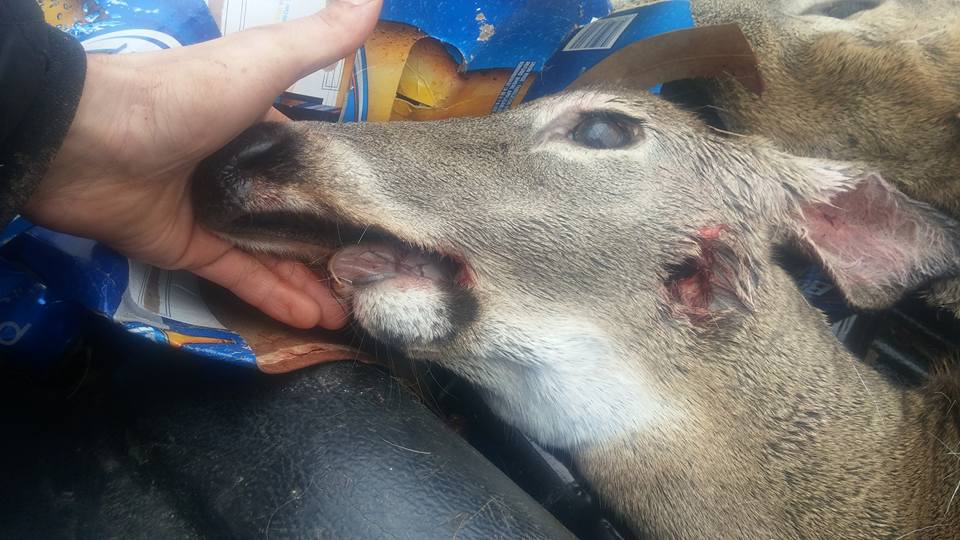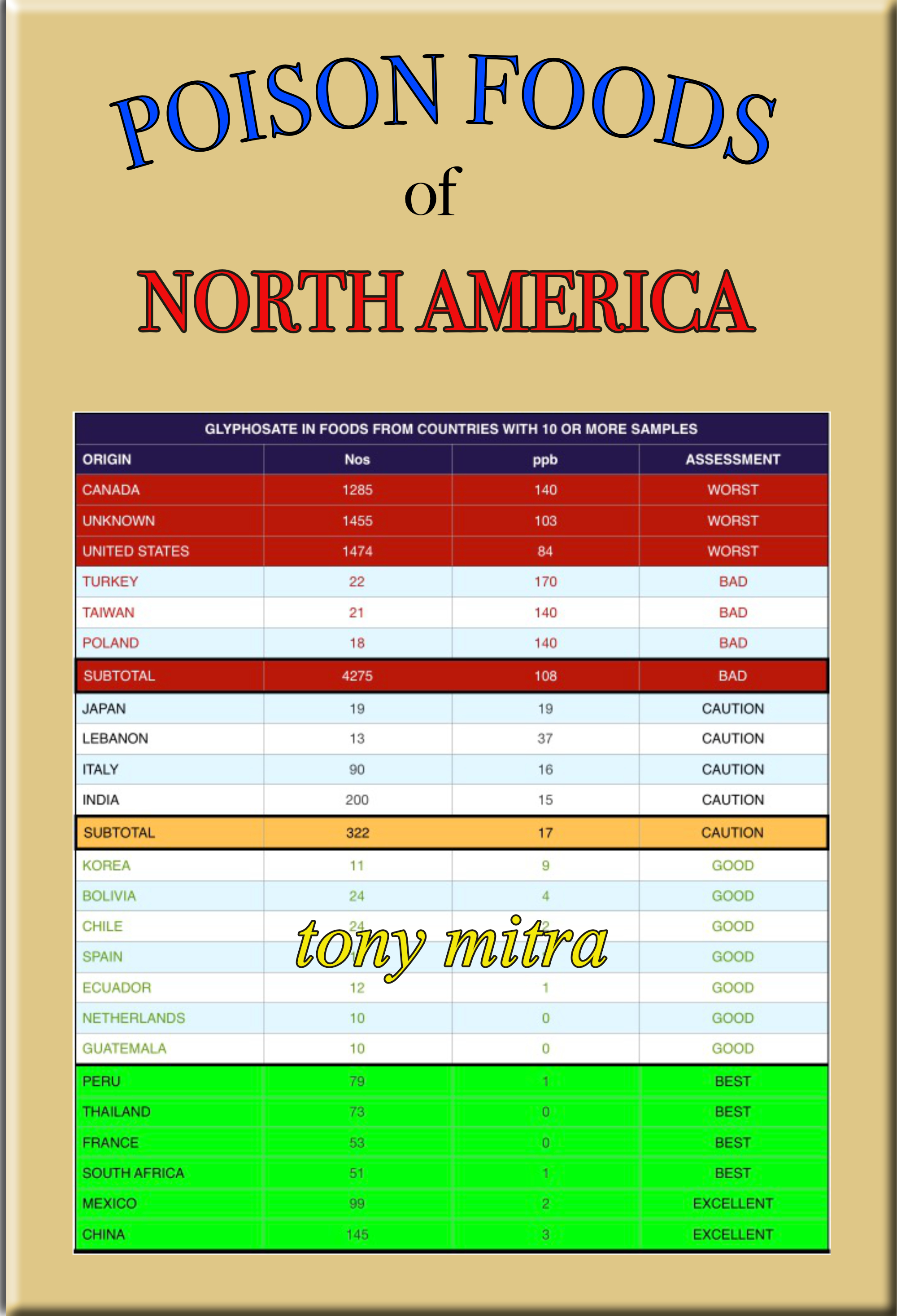IN the last few days, I have had a number of exchanges from people in New Brunswick, regarding a near collapse of big game wildlife, suspected through herbicide spray over the forests on one side, and a long lasting sad story of people getting sick from the same as power companies spray the ground under power lines that border human habitation. Here are a few quick observations and calculations. New Brunswick is under a peculiar and undesirable condition of a single corporation having a stranglehold on the province and able to manipulate government regulations to suit its business model. It is also alleged that the spray chemicals might actually be paid for through taxpayer dollars.

Wall mounted deer head with overbite
Meanwhile, people of the province are pushing for a ban on spray and the effort is going door to door, having garnered tens of thousands of signatures in a province that is low in population.
Wild game meat cutting shops in Fredericton are reporting strange cases when they receive animals that were killed by hunters for butchering, where the deer heads show lower jaw severely under developed (having an overbite). Others have seen similar animals in the wild, including animals with only one horn developed. Same is also observed and a few of such heads are also collected by wildlife scientists, looking to have them meaningfully tested somewhere.
Then there is the case of continuing and long lasting history of the province under a crippling history of a higher percentage of people being sick and dying of all kinds of ailments suspected from exposure to toxicity that are much less prevalent elsewhere. Some areas are so bad that almost every single family has dear ones that died, or are dying, or are suffering from severe illness, including permanent disabilities, even in young children and youths. And the suspected culprit is excess use of herbicides too close to these habitations for too long.

Deer killed by hunters with great overbite
The area is also well known for military testing of nasty chemicals such as agent orange and others that have been for decades and reportedly are still being tested over the ground in secret locations out of bounds for the people or media, and the effects may be spilling over to the local flora, fauna and humanity.
To make things worse, the province is under a sustained recession. There are no jobs except with the Government and a single corporation that owns everything, including involvement in the forest management and herbicide application. So, the people have nowhere to complain without risk of losing their job, and nowhere else to go. They are suffering silently.
It almost sounds like wilful genocide being committed on the Canadian people of the province through a sustained chemical attack ongoing for multiple generations.
Some of them contacted me.
My thoughts – it is neither easy nor perhaps the best idea to have the deformed deer heads sent off for some lab test for presence of Glyphosate. Why? Because:
- Canadian labs are not offering testing of animal tissue or body fluids for glyphosate, to the best of my knowledge. They only offer glyphosate testing on soil, water and some kinds of food and plant matter (foliage might be tested by labs that test plant matter, but if they will accept samples from the public or only from Govt needs to be investigated, since only one lab does this plant matter test and I am not sure if they only do it for the Govt or also for the people)
- The bone malformation in the deer are suspected to be caused through epigenetic effects from toxic influence while in embryonic stage in mother’s womb, or soon after birth while still going through major development process and before they have had time to develop a robust immune system. Therefore, testing for presence of glyphosate on an adult dead deer might not point to the root cause.
- Glyphosate might not be the only chemical involved in this malady, although it is the most used herbicide and suspected to be linked to a whole swath of ailments in humans and the living planet. Other chemicals equally suspect could be Killex, Mecoprop-P, 2,4-D etc.
Next – it may be a better idea to actually start a practice of measuring pollution levels of these chemicals in soil, water, and plant foliage periodically over some suspected areas.
Average test using Liquid Chromatography (HPLC-MSMS), for glyphosate goes to say around CAD 300 to 400 per sample, and cost for ELISA test goes to just over CAD 100. So, a mix of the two systems used might result in an average cost of say CAD 200 just for a rough estimate. ELISA test is indicative but considered not accurate or consistent (repeatable) enough to hold up in court. However, if the results also show up similar in multiple tests or also show similar results in LCMS methods, they will be good enough. Also, any suspect results can then be cross checked and verified by a more costlier test.
So, with an average cost of CAD 200, if sample of ground water, soil and foliage is collected from a sample test area (three samples) and if tests are done say four times a year, to see seasonal variation depending on spraying cycle, foliage growth period, pregnant animal foraging period, and newborn period (say four seasons in a year), then a single area will have 3×4 – a dozen samples to be tested. At CAD 200 that makes it CAD 2,400 annually – from one area and for one chemical (glyphosate). This breaks down to a budget of say CAD 200 per month.
Now, if one wishes to check against five chemicals and not just Glyphosate alone, and assuming test costs will be very similar for other chemicals too, then a single area would need a budget of 200×5 = 1,000 per month.
If ten such places need to be placed under continuous monitoring, in order to get an idea of the degree of chemical pollution to environment, then a monthly budget of 10k x 10 = 100K is needed.
In other words, a million dollars will cover ten years of data accumulation, covering ten test areas, for five pollutants, from three kinds of samples, tested four times a year.
This kind of money is unlikely to come from volunteers or the people. This can however be made available from provincial government, even if started small and then expanded.
The trick might be gathering enough public support to lean on their government to cough up with this testing regime.
At the end of the day, this problem may not be dealt with purely on a scientific platform because of two basic problems with science today:
- Independent study and verification of the safety of the industrial biocides are not being allowed, on various pretexts.
- Scientific institutions by and large are no more public funded, and are supported by the same industry that benefits from the production, sale and application of these biocides. And industry is not interested in funding any science project that might find a problem with their herbicides. Therefore science has become biased, and has lost its neutrality and objectivity.
So, if it cannot be solved within the ambit of science, how might it be addressed? A million dollar question, but I suspect it cannot also be solved by money. In other words, people donating to a good cause will not solve the problem. Why ? Well, if money could be the deciding factor then the people have already lost the battle because the herbicide pushing corporations and lobby have far more money than the people, and can easily outspend the public and also buy the government if the government is for sale.
So then, in my thinking, the only ace that the public has that has not yet been taken away, is their vote – at the federal, provincial and municipal level. How the people might get together on this issue – remains a million dollar question. But building a grassroots movement to resist this chemical attack seems to be a good place to start.
The people of New Brunswick already have performed a near miracle – they have dedicated people working towards the petition to ban spraying in NB, and have garnered over twenty thousand signatures, going literally door to door. That is a support base that, if used properly, should begin to make a difference.
My heart goes out to the people of New Brunswick, and I stand in solidarity, helping them in whichever way I can, starting with, but not ending with, this blog.
Meanwhile, I am looking for people in New Brunswick who have a story or an observation, or a personal statement, for making the rest of us more aware and alarmed at what appears to be a sustained chemical attack that the people of the province might have been subjected to, and how to find ways to stop this madness, and how initiate a public funded and transparent scheme of measuring the levels of toxic pollutants in the forest and residential environment, and how to trigger an independent analysis and study of the effect of such practices on the flora, fauna, people and biological diversity of the land, skies the estuaries and the oceans around New Brunswick. Everybody stands to benefit from such an endeavour, but most of all, it helps the people and the wildlife of NB who are at the front line of this chemical assault.
Any interested person – feel free to contact Tony Mitra by email.

Recent Blog attendance map.
Above blog attendance map shows degree of interest in the New Brunswick story. The red areas are sort of “hot” meaning multiple hits from them since this blog came up. Clearly, there is high level of interest from both coasts in Canada and also USA. It also shows some noticeable interest from pockets in western Europe as well as some of the eastern block nations such as Poland and also from the western part of Russia. This shows that some of the issues faced in New Brunswick might have a parallel, perhaps at a lesser extent, in matters of forest management in Northern Europe and Russia.
India has a long and sustained grassroots movement against GMO in general and a rising awareness about the herbicide that goes with GMO, though they are not, far as I know, too aware of herbicide use in forests. Anyhow, India has a healthy grassroots activism against chemicals in environment, who are also curious on similar goings on across the world. That might explain their level of curiosity here.
Then there are isolated points of interest in Taiwan, Malaysia, New Zealand, and the populated arc of south western Australia. Add isolated points of interest from Panama, Antigua, Colombia and Brazil – and that covers up central and south America. One would have to post in Spanish or Portuguese to get more response from there.
In the middle east, there is some interest from Israel and Iran – an indication that hazards of herbicide spray can find common ground among even arch enemies.
Africa is mostly missing, perhaps due to lack of internet access, or preoccupation with more pressing issues of their lives. Cape Town is the sole exception.
That’s all for today. So far so good.
Update Sunday, March 8, 2020
This is an update on this over three year old blog. A lot has happened in these three years. My success in getting the Canadian Government to test thousands of food samples for glyphosate is one. Handing me over all that test data and me analysing them to discover that Canada along with the US produces far and away the most toxic food on earth with glyphosate poisoning – and publishing all that in the book “Poison Foods of North America” is another. Both of these actually happened before this blog was written.
And then there were follow up issues such as me warning folks from India that by importing toxic lentils or other grains from Canada, the nation was mass poisoning its own people. This warning reached the floor of the Indian Parliament and resulted in the food ministry, something that India has but Canada does not, deciding to test imported Canadian lentils for glyphosate, and the Canadian Government trying to impress India that there was nothing to worry about as the level of glyphosate was within safe limits. The safe limits in Canada is astronomically high without any proof of safety, while in India, which has not approved use of glyphosate in agriculture, the effective safe limit is zero – and so on.
I met Rod Cumberland last time we visited Fredericton, to speak about glyphosate years ago. Lately he got fired from the college of forestry on a cockamamie pretext, while the real reason was his continued objection to the use of glyphosate spray over forests. It made me so mad that I ended up sending a nasty public letter to the Governor of New Brunswick accusing the provincial government of acting like a regime of a fourth world warlord, a letter which the Governor chose not to respond to.
There are people that sent me emails and I ended up speaking with a few. There is perhaps a plan to make a video or two, with voice recordings of some of the NB residents and activists. Some concerned people from British Columbia are considering visiting New Brunswick to check up who all are already there trying to fight the Mono-corporation Goliath Irvin and perhaps join the fracas of other protesters, movement initiators and general noise makers.
On retrospect I do believe the poisoning of New Brunswick is rooted not just in glyphosate, but poisoning of its economic and political landscape. The people are either employed by Irvin or by the Government which appear to be owned by Irvin. There is nobody else. As a result most folks who have relatives earning wages from one of these two employers, are afraid to shout too loudly against the chemical attack for fear of their loved ones turning up unemployed. It is almost unbelievable that such a thing can happen in Canada. In olden days, at least in Europe and Asia, these are reasons why heads used to end up on pikes.
I wonder why the church does not stand up on behalf of the people and the land. They are supposed to have independent financial resources, do they not? God and Jesus used to be a powerful motivator once. I am saying this although I am a Hindu turned agnostic tending to be an atheist. I appeal to the various church groups to get together and lead the way, or try to find a path out of this nightmare.
Anyhow, I do believe this needs to somehow turn into a political movement, and not just for New Brunswick. I have been generally greatly disappointed by the political class the world over, but understand that ultimately, it is the fault of the people.
If Irvin has a monopoly on business there, it is unto the people to break that monopoly. If the government is violating its constitutional duty and working for Irvin, it is still the duty of the people to fix it. At the end of the day, the buck stops at the feet of the people. But, in all history, people only rise up when the right leader leads them to resist tyranny.
New Brunswick sorely needs a local leader that will shepherd the people. We the rest of Canada need to follow, support and learn from it.
A fresh blog may appear on this. Link to such a blog will appear here.
Stay tuned. My email: Tony.mitra@gmail.com
